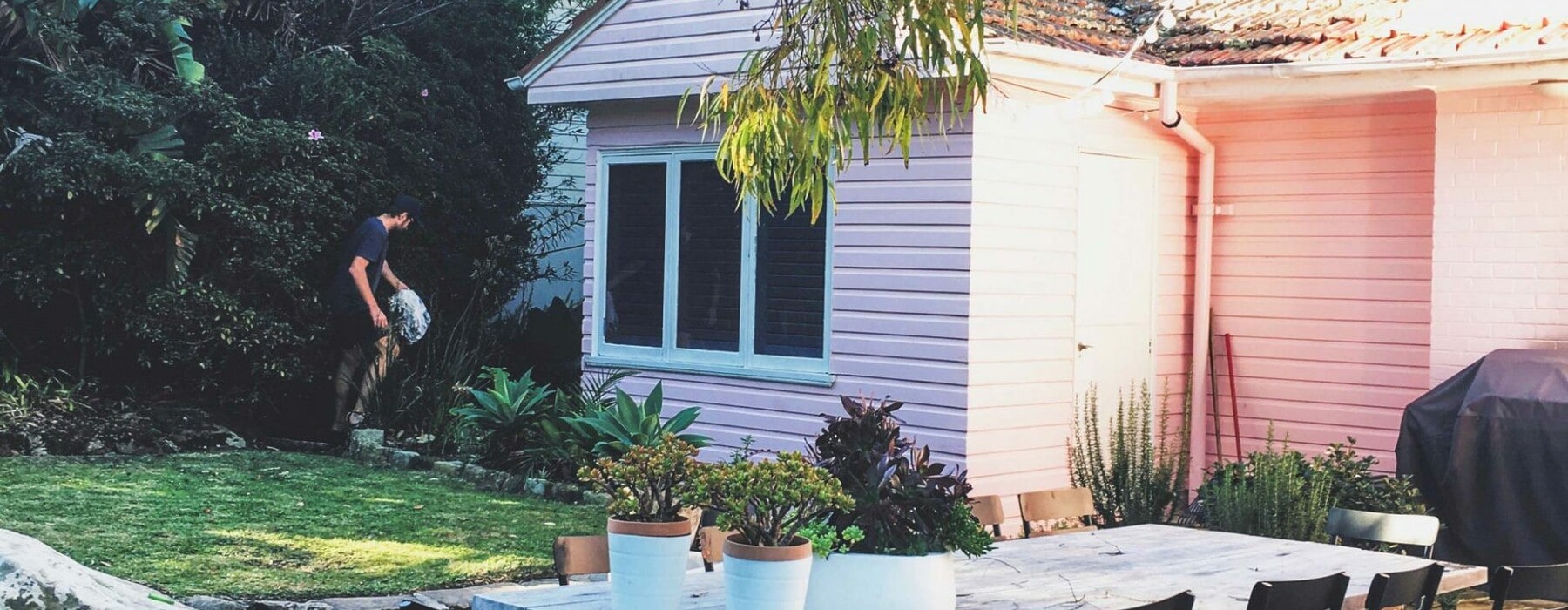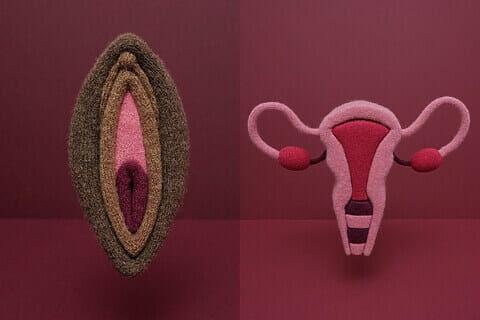Saying goodbye to most of their possessions was a difficult but life-changing experience for one downsizing couple, who’ve written about what they learnt in a new book.
Do we own our things or do they possess us? Jacqui Lewis and Arran Russell embarked on an experiment to answer this question when they downsized from a huge designer rental in Sydney to a cottage in Palm Beach, north of the city. It was a quarter of the size of their previous home and adorably retro, with a sunny garden and glimpses of the ocean.

They gave away or sold almost all their possessions, donating the proceeds to charity. “I had thought this would be a beautiful experience, at once both cathartic and charitable,” writes Jacqui in their book High Grade Living. “In truth, it was gruelling, sweaty and devastatingly disappointing. No one wanted our things even though we had paid a fortune for them … It was a giant lesson for us in consumerism.”
There were upsides though. Living without a dishwasher meant discovering how wonderful it was to wash dishes in a tiny sink while looking out onto a beautiful garden. There was more time together as a family to lie in the garden or swim in the ocean.

The experience is reflected in a chapter in their book, which also has sections on meditation, creativity and relationships, and aims to help those who are anxious and overwhelmed to become more creative, grounded and happy. “High-grade living” is about living in alignment with your higher self – about discovering and embracing what is you and letting go of what is not, says Jacqui.
The following extract from Jacqui and Arran’s book looks at the way home is a retreat from our hyper-engaged modern lives and a place to renew and nourish ourselves.
Make it meaningful
Creating your high-grade home is an ongoing, individual process that will be unique to you. For some, it will mean absolute minimalism, paring back to the bare essentials. For others, it means developing a collection of personal and meaningful art, books and objects.
It’s a journey through your home, but with a deep sense of purpose and alignment with who you are and your values. A luxurious home does not have to mean expensive furniture and famous art. The new luxury is about meaning and delight, and provides you with a platform for experience and growth.

Understanding your patterns
Take time to really think about what is important to you and what has been driving the things you buy, then answer these questions:
- What ultimately brings you happiness?
- What gives you contentment?
- How easy is it for you to embrace simplicity over complexity?
- What do your purchases reveal about you?
- How does this inform you moving forward?
Audit, edit and refine
Our homes are our sanctuaries and should serve as inviting retreats from the frenzy of the exterior world. Ask yourself, how does your home feel when you walk into it? What ambience does it offer? Is it comfortable and inviting or is it a mess? To improve the impact your home has on your daily life, begin with an audit, edit and refine.
First is the audit, where you assess your surroundings. As you audit each room in your home, keep in mind the following questions:
- What is triggering a materialistic response?
- Could you be consuming or hoarding to mask anything?
- Are you culling too violently or controlling too much?
- Which rooms are inviting and provide calm and tranquillity?
- Which rooms feel hectic?
- What kind of home do you want to have?
Some people are very frugal by nature, and prefer practicality over beauty. Is this your preferred way of living?
Some people are very extravagant and showy, and prefer beauty over practicality. Is this your preferred way of living?
Remember, there is no right or wrong kind of home. This is the beauty of high-grade living – you get to create the home you actually want that allows your best self to shine through.
This process is about releasing yourself from all the “shoulds” in your home, moving toward an intuitive way of living, and having your home support you through that. Understanding more deeply your own sense of beauty – what you desire and love, as opposed to the current trends in magazines and on blogs – is a process that will take curiosity and openness. This is the essence of high-grade living.
After auditing, the process of editing begins. This isn’t about giving away everything you own! However, a giant culling of all your objects is worthwhile in the reframing of what a high-grade home means to you.
Ask yourself what has meaning and what has simply accumulated over the years. If there’s an item in your home that’s broken or doesn’t have meaning or purpose, donate it and move it on.
What begins to occur through the editing process is that you start to recognise habits and patterns. Your potentially irrelevant and redundant ways of living start to become evident. It’s incredibly cathartic. You will begin to see how you hold onto things in various areas of your life and where you could be letting go more frequently.
You may find you’re attached to certain things simply because they’re extravagant or expensive, but they don’t bring any real value to your home or your life. These purchases are often made on a whim, or during times when you’ve felt stressed and uncertain and needed some retail therapy. It’s important to be honest!
Next, you refine. Refining is the process of gently revisiting a particular area to help it upgrade along with yourself and your life as you grow and evolve.
It helps avoid stagnancy and aids you in engaging with areas of your life instead of getting stuck, or having life fly by you. If you avoid refining, then you will end up back where you started. Refining doesn’t need to be laborious; it should instead be embraced as a mindful philosophy. Look around your home and ask yourself these questions:
- Is this reflective of who I am and how I want to live?
- Does my home now support me (and/or those I live with) in ways that are nourishing?
Revisiting this process once a year will help your home evolve and not become stagnant.
If we didn’t acquire a single new item, and didn’t change as people, this wouldn’t be necessary. However, we are constantly evolving, and our spaces of retreat must come along for the ride. Deliberate choices create a curated life rather than a chaotic one.
Expressing creatively
The audit, edit and refine principle is best employed to understand your creative expression. Most of the time we need to clear out before we can invite in.
It’s very hard to get a clear view of where you can enhance and flourish in and among chaos. So dive deeply and then invite in your creative expression. Answering the following questions should help:
- When you view your home, and its uses and purposes, how are you creatively expressing yourself?
- Can areas of your home potentially become less fixed and more fluid?
- Does the art reflect you and your creativity?
- Does the furniture feel like an accurate expression of who you are?
- Creativity is light, fun, dynamic. Does your home reflect this?
- How could you create more space for creative expression within each room?
Sharing your spaces
With fresh eyes, look at each room in your house and how it is used, and then think about the following questions:
- How can you enhance the use of this space?
- Should some things be moved to different spaces?
- How can you create an area for ritual in your home?
- Is there a space that could become a dedicated reading nook? Or a place to draw and be creative?
Empty out
The Japanese concept of kyo-jitsu explains that when something is too full, something else has to empty. It’s a term frequently used in energetics (ki), macrobiotics and health.
In the Western world, it’s common for us to just concentrate on filling, acquiring more of this, more of that. Even spiritually, there is a push to become “more fulfilled”. This attitude comes at a cost, as it can create a drain on something else.
The key is balance, and this applies to design too. Some wonderful examples can be found in temples and their use of negative space. One area might be very detailed and full, and an opposing area spacious and serene.
Balance doesn’t mean you must even out all aspects of your life so you’re putting the same amount of energy into everything, and this applies to your home as well. It’s more about carving out a little more here, and filling a touch more there, sometimes on a dramatic scale. Where can you live at a fast pace, and where can you slow down? Where can you create space and breadth, and where can you overflow a little? What can you absorb, and what can you resist?
Understanding zanshin
Zanshin is a Zen term that means appreciating the entire cosmos at all times. It is a state of utter present awareness of everything that is, where the mind is completely at peace and observant of all things. It is the recognition that everything is connected and that the entire universe is based on our perceptions and our projections of reality.
When you observe simply what is, you can see the beauty in the entire sequence of events, or nature, of your life. Zanshin is about appreciating with complete presence that everything is important – walking, dressing, sitting in traffic, drinking a coffee. It avoids favouring certain activities and embraces every act with reverence.
Zanshin can pull you away from materialism and into appreciation. It’s less about the objects you have around you, and more about the energy and the atmosphere you create, and the love that can be shared within your home.









